|
|
|
Sort Order |
|
|
|
Items / Page
|
|
|
|
|
|
|
| Srl | Item |
| 1 |
ID:
100957


|
|
|
|
|
| Publication |
2010.
|
| Summary/Abstract |
The Cold Start doctrine is an innovative exercise. While Cold Start discusses how to start the campaign, equal thinking needs to attend how to end it. On the conventional level, the learning is that the Cold Start offensives of the integrated battle groups need to be delinked from those of the strike corps. Plausible political aims cannot be visualised that make nuclear risk of launch of strike corps offensives worth running. On the nuclear front, fallout of the scenario considered is on the doctrine of 'massive' nuclear retaliation. This has its limitations in reacting to nuclear strikes of low opprobrium quotient. Moving to 'flexible' nuclear retaliation countenancing ending an exchange at the lowest possible level may be preferable instead. In the nuclear age, utility of military force has reached its limits. The future lies in energising non-military problem solving approaches.
|
|
|
|
|
|
|
|
|
|
|
|
|
|
|
|
| 2 |
ID:
100966
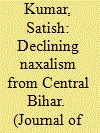

|
|
|
|
|
| Publication |
2010.
|
| Summary/Abstract |
The Naxal problem has become the biggest internal threat to the country. Especially after the comments of the Prime Minister Manmohan Singh in 2007, it has become a matter of concern as well as a subject of academic debate. The new thought, innovative ideas and fresh planning have been developed to address this issue extensively and intensively. In this backdrop, a case study of Central Bihar becomes relevant to focus the light on this issue. It is an established fact that Naxalism in Bihar had made its route through Central Bihar. When the Counterinsurgency mechanism crushed the first bubbles of Naxalism in West Bengal and Andhra Pradesh, it found its breeding ground in Central Bihar. Repeated massacres and Naxal terror in Central Bihar became the concern for the country in 1980s and 1990s. It argues that the changing socio-economic conditions along with other factors massively restricted the Maoist popularity and strength in the Central Bihar.
|
|
|
|
|
|
|
|
|
|
|
|
|
|
|
|
| 3 |
ID:
100962
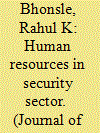

|
|
|
|
|
| Publication |
2010.
|
| Summary/Abstract |
The challenge of management of human resources may be the most profound in the security sector in the years ahead given transformations happening globally and enhancement of human potential and opportunities for individual growth. The national security sector extending from the military to private security guards denotes the plethora of skills sets required which vary from that of handling highly sophisticated and lethal missile arsenal, to commandeering large aircraft carriers and submarines to securing public space in metropolitan cities. Selection, training, motivation and incentivizing the force will be a major challenge for the 21st Century. The need of the hour is, therefore, to have an integrated human resource development policy so that lateral skills can be utilized across the three spectrums of defence, paramilitary and police and private security and enhance talent utilization through motivation. It argues that this will lead to effective and economic utilization of manpower with national ownership rather than as a stove piped resource, corresponding savings to the ex-chequer while adding to proficiency of security forces.
|
|
|
|
|
|
|
|
|
|
|
|
|
|
|
|
| 4 |
ID:
100967
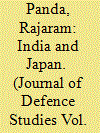

|
|
|
|
|
| Publication |
2010.
|
| Summary/Abstract |
The strategic environment of the world, particularly in Asia, is in a state of dramatic flux. The overwhelming economic and military presence of the United States in Asia is on the wane. China is a rising power, both economically and militarily, and its power projection capabilities are causing concern amongst its neighbours. Though the United States is a declining power, China is not the logical successor, not at least in the near term. These developments have led to realignment of power equations between countries in Asia. In this unfolding strategic landscape, India and Japan, two important players in Asia, are exploring the strategic dimension of their relationships. While growth momentum in the economic domain is not at the desired level, the institutional political structure provides the platform for honing the potentials to their mutual benefits. As a result, a great deal of commonalities is now visible in strengthening bilateral ties in political, economic and security fields. The present paper makes an attempt to evaluate and examine this dimension of the bilateral relationship and the economic dimension that compliments this. The author argues that the developments in the bilateral relations in all fronts suggest that in the coming decade, India-Japan bilateral ties will play critical role in stabilizing the emergence of the new Asian order, in which India, Japan and China can be responsible stakeholders.
|
|
|
|
|
|
|
|
|
|
|
|
|
|
|
|
| 5 |
ID:
100969


|
|
|
|
|
| Publication |
2010.
|
| Summary/Abstract |
Defence cooperation and military engagement between India and China are aspects of the complex mix of conflict and cooperation approach to bilateral relations between the two Asian giants. It is based on the presumption that there is a security dilemma between the two countries. However, it recognises the framework and postulates of what is called cooperative security. Through the liberal institutionalist's perspective, it argues that India-China defence cooperation and military engagement are not only possible but also desirable. For these two biggest developing nations of the world, peace and friendship between them are not only in their mutual interests, but also important for bringing peace, stability and prosperity to South Asia.
|
|
|
|
|
|
|
|
|
|
|
|
|
|
|
|
| 6 |
ID:
100952
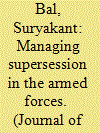

|
|
|
|
|
| Publication |
2010.
|
| Summary/Abstract |
Supersession is too important an aspect of organizational existence to be dismissed lightly. It is a situation to be managed jointly by the organization and affected individual with the clear understanding that organizational interests are overriding. The Human Resources Management (HRM) approach aims to ensure that staffing manning of an organization effectively meets the quantitative and qualitative aspects at all times to ensure efficiency and effectiveness. An important element of HRM is Human Resource Planning (HRP). This calls for long-term manpower projections based on which intake would be determined. This paper makes attempt to identify key issues using the 'HRM approach' in managing supersession. While staking no claim to provide definitive answers (a rather tall expectation) the endeavour has been to highlight an approach within the framework of contemporary motivational theories.
|
|
|
|
|
|
|
|
|
|
|
|
|
|
|
|
| 7 |
ID:
100972
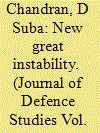

|
|
|
|
|
| Publication |
2010.
|
| Summary/Abstract |
The present paper discusses about the new great instability in Afghanistan which had emerged after 2001. It builds four scenarios by looking into the impending American withdrawal from Afghanistan and states that for President Obama, a stable and democratic government is most desirable but it would prefer to leave it after building a coalition government with local actors as the US is more worried about a stable government in Afghanistan, not necessarily a democratic one. It argues that with India-Pakistan peace process in doldrums, and no signs of internal political stability in Pakistan, an impending American exit from Afghanistan, have huge implications for India, especially in Jammu and Kashmir (J&K).
|
|
|
|
|
|
|
|
|
|
|
|
|
|
|
|
| 8 |
ID:
100950
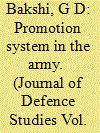

|
|
|
|
|
| Publication |
2010.
|
| Summary/Abstract |
In practice, it has been found that a peacetime army tends to atrophy and lose its war fighting orientation. It develops a lopsided emphasis on peacetime routine, spit and polish. In fact, a wartime army may well be the very anti-thesis of a peacetime army. Years of non-use of the military instrument sometimes results in the rusting of its value system and ethos. It is a primary challenge for military leaders, therefore, to maintain and sustain peak combat efficiency during spells of peace; to anticipate the nature of future conflicts and organize, equip and train the army to prepare for these.
|
|
|
|
|
|
|
|
|
|
|
|
|
|
|
|
| 9 |
ID:
100971


|
|
|
|
|
| Publication |
2010.
|
| Summary/Abstract |
The current spurt in violent activities in valley and death of civilians in police actions against unruly mobs is a cause of serious concern and requires introspection not only by the government but also by the political parties including the separatists. The demands of separatists to revoke AFSPA and Public Safety Act from the valley and release of all political prisoners in the prevailing circumstances is neither justifiable nor in the interest of Kashmiri people. Such demands will only aid anti-national motives of terrorist outfits and external forces.
|
|
|
|
|
|
|
|
|
|
|
|
|
|
|
|
| 10 |
ID:
100959


|
|
|
|
|
| Publication |
2010.
|
| Summary/Abstract |
Manpower costs are increasingly becoming unmanageable and are driving national security planners towards thinking creatively about what used to be called 'affordable defence'. Despite leap-frogging from third to fourth generation weapons technologies in the short span of about two decades, modern armed forces are still far from being able to effect substantive reductions in manpower by substituting fighting personnel with innovative technologies while ensuring operational effectiveness. In fact, more often than not, technological solutions are proving to be costlier than the present arrangements for security. It may be quite a long wait to see which way the technology cookie crumbles. In India's case, because of the Army's extensive commitments in border management and manpower-intensive internal security duties, it is unable to undertake major reduction in its manpower. Direct personnel costs amount to almost 50 per cent of the Army's revenue budget and indirect costs add further to the burden. As the defence budget is unlikely to increase beyond 2.5 per cent of the GDP, the Army's modernisation plans have fallen way behind the required qualitative levels. It argues that there is a need to seek innovative and creative solutions to reduce the costs of manpower even if the manpower itself cannot be reduced in large numbers at present.
|
|
|
|
|
|
|
|
|
|
|
|
|
|
|
|
| 11 |
ID:
100964
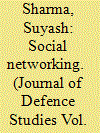

|
|
|
|
|
| Publication |
2010.
|
| Summary/Abstract |
The social networking sites can be exploited by the cyber operators by infiltration and influencing the opinion where feasible. Cyber espionage has already became the cornerstone of some nations, where international cyber security agencies have reasons to believe, of state complicity in major hacking, denial of service attacks in the last couple of years. Since social networks become easy prey to such agencies, there is a need to increase awareness of defence personal about their vulnerabilities.
|
|
|
|
|
|
|
|
|
|
|
|
|
|
|
|
|
|
|
|
|